The ASUS ROG Strix B360-G Gaming Review: A Polarizing $100 Motherboard Design
by Joe Shields on September 25, 2018 8:00 AM EST- Posted in
- Motherboards
- Intel
- Asus
- MicroATX
- CrossFire
- M.2
- Coffee Lake
- i7-8700K
- B360
Visual Inspection
Our first close look at the board shows the MicroATX offering has quite a bit going on visually. All the stenciling spread across the length of the board is pretty hard to miss. We can see two large heatsinks as well as an IO cover which is a bit different from the B360 boards we have reviewed so far - up to this point other boards have eschewed large heatsinks, and focused on cost savings. To ASUS' credit the rear IO plate is also integrated giving the board a premium look on that front.
The PCB is black with all connectors coming in black as well. The primary PCIe slot is fortified to assist with large and heavy graphics cards. The ASUS ROG symbol graces the chipset heatsink. The stenciling using words/phrases doesn't really do much for the look of the board. I cannot say how it will be received by the public, but I know I would have preferred the board without that design for sure.
The ASUS B360-G Gaming also includes LEDs on the bottom part of the board and run along the left side close to the audio separation strip. The LEDs are RED in color and creates a nice theme matching glow from the bottom of the board. The colors are not able to be changed by the Aura software. That said, the board does include an RGB strip header which makes adding your own strip easy.
On the cooling side of things, the mATX board gives users a total of four 4-pin fan connectors located around the board. The CPU fan header is located above and to the right of the CPU socket next to the first DRAM slot. A chassis fan header, as well as an AIO_Pump connector, are located mid-board behind the audio stack on the left side of the board and above the primary PCIe slot. The last chassis fan header is located on the bottom of the board below the chipset. ASUS does not mention the output capabilities of these headers. The fans are able to be controlled through the BIOS and the AI Suite software with the ports support both PWM and DC control.
The power delivery section on the B360-G Gaming uses ASUS' Digi+ VRM which is likely based off of an International Rectifier part and controls the six phases we are able to see. The low and high side MOSFETs are On Semiconductor 4C06B and 4C10B ICs. This setup was plenty to keep a stock i7-8700K in check.
Swing around to the right side of the board, we can see the four single-sided locking DRAM slots and a full set of six SATA ports are all visible. Two of the SATA ports are mounted horizontally while the four others are oriented vertically. We are also able to see a USB 3.0 header, as well as the 24-pin ATX power lead for the board.
On the bottom half of the board, starting on the left side, we are able to see the Supreme FX audio chip which ASUS says has a better SNR than the Realtek ALC1220 codecs, is shielded and uses Nichicon audio caps. It also includes two onboard op amps for the front panel with a 32-600 Ohm range for headphones. It is nice to see premium audio used on a chipset designed to be more cost-effective than including higher-end features.
The middle is where we see the two M.2 slots (just above each full-length PCIe slot) as well as four PCIe slots. The first/top PCIe slot is fortified with ASUS' Safeslot to prevent shearing from heavy video cards and is the primary slot for the GPU. We can also see two x1 slots and the second full-length PCIe slot (runs at x4). The top slot is fed from the CPU while the x1 slots and bottom slot are fed from the chipset. This configuration allows for the board to support Crossfire setups, but not NVIDIA SLI.
| ASUS ROG Strix B360-G Gaming CPU PCIe Layout | ||
| 16-Lane Single |
16-Lane Dual |
|
| PCIe 1 | @x16 | @x16 |
| PCIe 4 (Chipset) |
- | @x4 |
| SLI | - | No |
| Crossfire | - | Yes |
Outside of that, we can see miscellaneous headers across the bottom. These range from front panel audio, USB 2.0 headers, as well as a chassis fan, and finally, the front panel header on the bottom right-hand corner.
The rear IO panel is pretty full featured for a B360 motherboard including USB 2.0, 3.0, and 3.1 (10 Gbps) ports on the back along with a full audio stack including an optical jack. Video output is handled by an HDMI port and DVI-D port. The board also includes a PS/2 port for legacy keyboard/mice as well as a single LAN port which includes ASUS' anti-surge guard to protect from ESD. The only core thing missing from the rear from a pricier system is a Type-C port.
- 1x PS/2 keyboard/mouse combo port
- 1 x DVI-D
- 1 x HDMI
- 2 x USB 3.1 (10 Gbps) Type-A ports
- 1 x Optical S/PDIF out
- 5 x Gold-plated audio jacks
- 2 x USB 3.0 ports (blue)
- 2 x USB 2.0 ports (black)
In the Box
ASUS includes the following:
The package includes everything a user needs to set the board up and running.
- User Manual
- Support DVD
- 2 x SATA cables
- 1 x M.2 screw
- 1 x Door hanger
- 1 x cable tie package
- 1 x ROG stickers



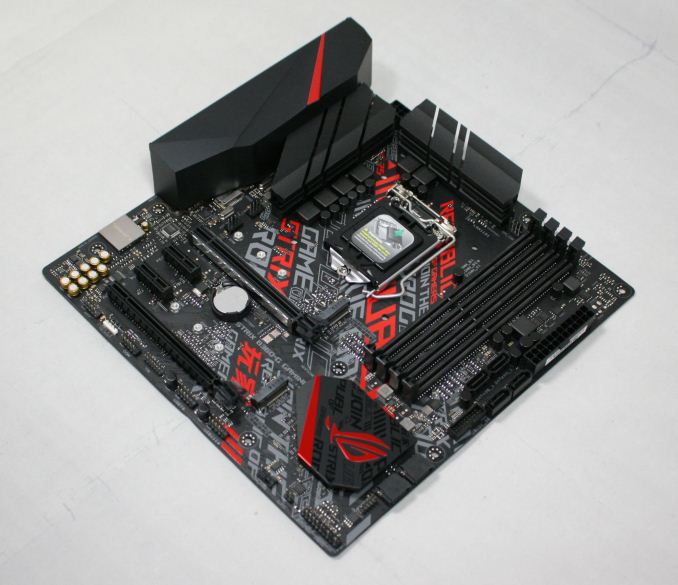
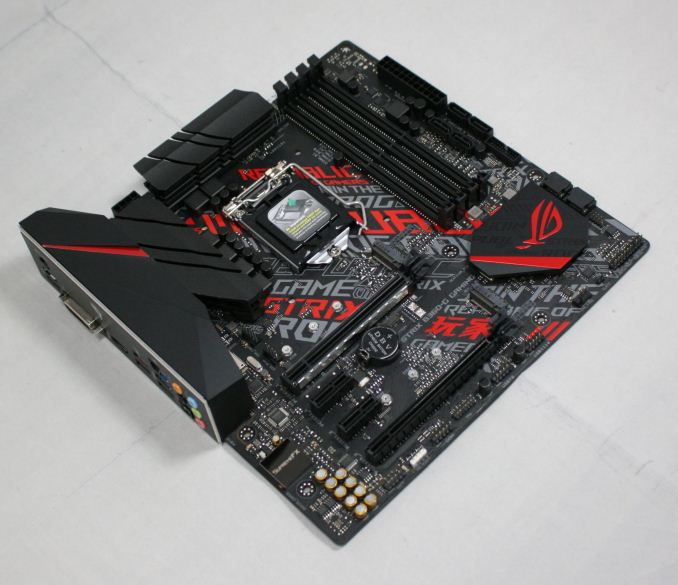
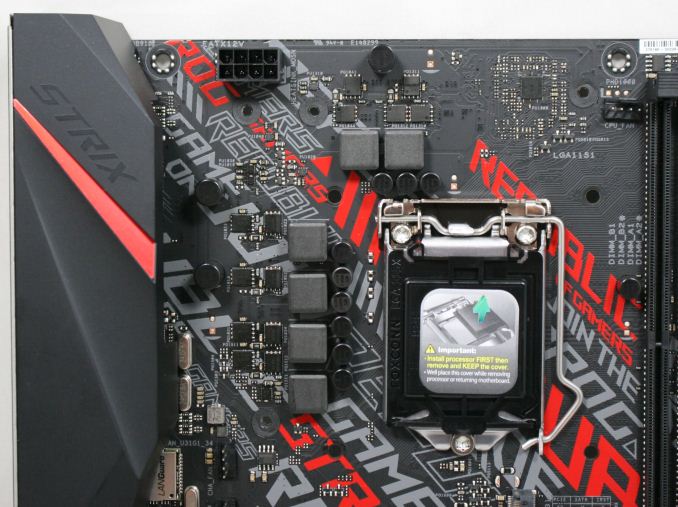
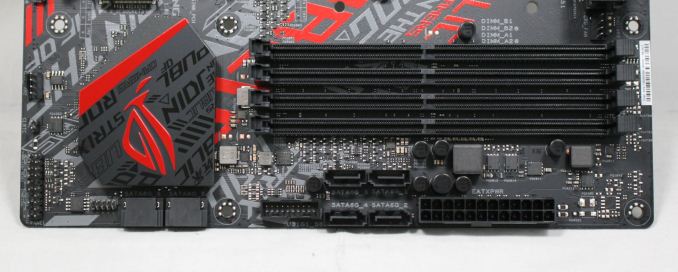
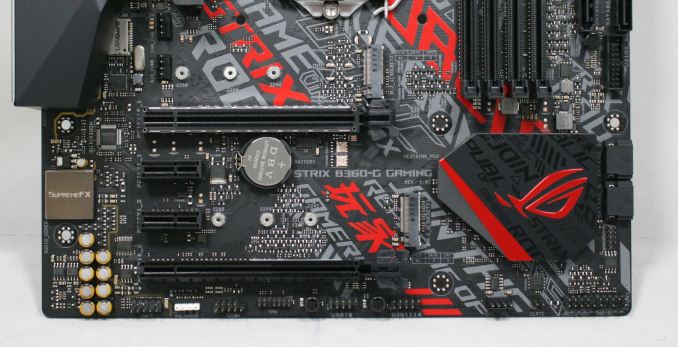
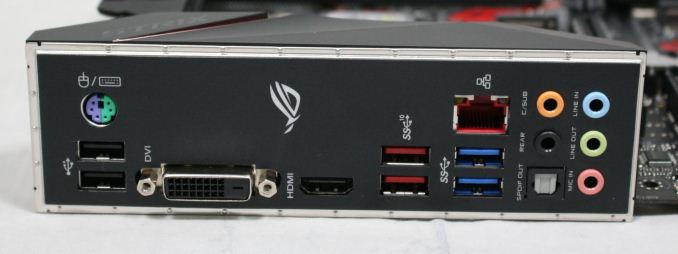















26 Comments
View All Comments
Threska - Tuesday, September 25, 2018 - link
Diagnostic displays come in handy when builds go south, or hardware dies. As for the mATX, I imagine much like houses, people are downsizing, so the computer doesn't eat the desk.Samus - Tuesday, September 25, 2018 - link
Yep. Throw it in a black case and move on. Who cares what the internals of a PC look like if you never see them.Holliday75 - Tuesday, September 25, 2018 - link
Yup thinking the same thing. If I was building a new Intel box right now I would probably purchase this board and never look at it again unless I was adding a drive or fixing something.Oxford Guy - Wednesday, September 26, 2018 - link
You do see them. Black-on-black is the bane of the computer installer's life. Board makers used to understand this and color-coded everything. Instead of ease-of-use, though, we have to be teenybopper edgelords these days. Skulls on SSDs coupled with Rainbow Brite LEDs.V900 - Thursday, September 27, 2018 - link
Oh you poor, naive fool!How will you communicate the fact that you like to game to people, with the case all locked up like that, hmm?
Didn't think about that, did you?
You know what people who come to visit you will think?
"That Samus guy is kinda cool, just too bad he's not a gamer!" Yup! Thats exactly what theyll think.
desolation0 - Friday, September 28, 2018 - link
If they don't get it from the original Unreal flyby benchmark test as screensaver I'm not sure they can be helped.willis936 - Tuesday, September 25, 2018 - link
In the DPC Latency section of the System Performance page:"Our DPC latency results for the B360-G Gaming 122 µs which is about par for the course after our minor script adjustments."
Compared to the last ryzen mobo review (asrock x470):
https://www.anandtech.com/show/12666/the-asrock-x4...
"While none of the manufacturers of the boards tested on the AM4 socket so far have been optimized for DPC latency,"
Am I to understand that sub 100 us is being considered "not optimized for DPC latency" while only two of the current list of coffee lake tested mobos approach 100 us are?
Is this an oversight or is there something I'm missing? It looks like the AM4 platform is currently ahead of coffee lake in terms of DPC latency.
Oxford Guy - Wednesday, September 26, 2018 - link
I wasn't sure what motherboard I could but that would let me play computer games. So, when I saw Gaming in the title I knew it was the board I needed.Oxford Guy - Wednesday, September 26, 2018 - link
I would like to suggest to these manufacturers, though, that they strongly consider putting a bleeding severed head on the plastic heatsinks, and prominently on the packaging also. Bleeding severed heads compliment SSDs with skulls on them and encourage people to think positively about the product.96redformula - Thursday, September 27, 2018 - link
I couldn't resist picking one up in my Mobo search a week ago a half ago at $90 shipped to the door. The text is non existent once it goes into a case, no big deal, but it sure did make me rethink it when I was purchasing it. The video card and aftermarket HSF cover it all just fine :)